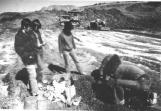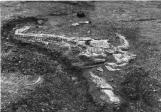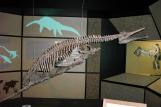15
With the help of the Pembina Mountain Clays mining company, previous Curator Henry Isaak, and volunteer high school students, the Canadian Fossil Discovery Centre (formerly the Morden and District Museum) has excavated over 500 specimens.The excavations are all from the Pembina Hills with discoveries still being made today.
17
One of the original specimens collected was an immature short-necked plesiosaur. The fauna swimming in the Western Interior Seaway may have fell subject to predation, disease or a cataclysmic event.The remains of an organism sink down to the seafloor. If the circumstances are ideal (rapid burial with no oxygen), the skeletal remains may be preserved and turned into a fossil.
Particles will settle down, covering the specimen. Over millions of years the specimen is buried by these tiny particles forming a rock. It is not until a geological event or climatic change occurs that the buried fossil may be exposed.


